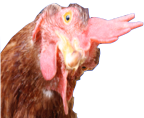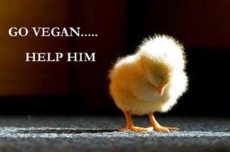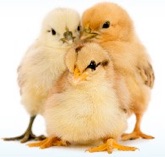


FOLLOW
LAYING HENS



CHOOSE VEGAN is funded entirely by public donations. Animals depend on your generosity to continue vital work to expose and end animal abuse. Thank you for helping to free animals from cruelty.
CHOOSE VEGAN FOR LAYING HENS
Hen eggs are a reproductive body laid by the female that consist of an ovum surrounded by nutrient material, layers of membrane and a protective outer shell. Todays egg laying hens are descended from the Red Jungle fowl (Gallus gallus) of Asia which lays around 60 eggs a year.Modern breeds of domestic hen have been selectively bred to lay over 300 eggs a year.
Selective breeding for high egg production has resulted in distinct strains of birds for egg laying and for meat production. Birds of the laying strain do not make good meat birds and as a result male birds of the laying strain, who neither lay eggs nor produce meat efficiently, are killed when a day old. Female hens in egg farms suffer from a range of welfare problems and restrictions during their lifetime. When the productivity of the flock falls the hens are sent for slaughter and are quickly replaced with more profitable animals. Laying hens are normally only kept for one year before they are slaughtered - their natural lifespan is around seven years. This slaughter of spent hens takes place even in free range systems.






ABOUT US
MEDIA
CONNECT
SUPPORT
Choose Vegan
the voice for animals
CONTACT





WE BELIEVE IN A WORLD WITHOUT SLAUGHTER HOUSES.

You Do not need to eat eggs to have a healthy balanced diet, It is very easy to make egg-free cakes, quiches, mousses and other dishes.
Cages must provide at least 750 cm2 per hen, of which 600 cm2 should be useable area,the remaining area being shared space for items such as a nest box.Enriched cages should have litter, a claw-shortening device and a perch. The space in so called enriched cages is equivalent to roughly an A4-sized piece of paper, these cage deprive the birds of the ability to fulfill their natural behaviors. Their bones are still classed as osteoporotic and feather pecking has also been described as redirected ground pecking as caged hens are unable to ground peck, In an effort to prevent feather pecking, farmers debeak the birds (see debeaking).
Caged hens
Barn eggs are produced from hens kept in flocks confined to a shed with no access to the outdoors. Hens may be stocked at a density of 12 hens per square metre. Litter should be provided for scratching and dust bathing but only needs to cover one third of the ground surface. Nest boxes should be provided at 1 nest box for every 7 hens or a communal nest for every 120 hens. Perches should also be provided allowing 15cm of perch per hen. Hens in Barn systems are debeaked in an attempt to control feather pecking behaviour.
Barn system
Birds in free range systems can be stocked at a density of 9 hens per square metre. In addition the hens must have continuous daytime access to open runs that should mainly be covered with vegetation and at a maximum stocking density of 2,500 birds per hectare which equates to 4 square metres per hen. Birds in free range systems may be debeaked to combat feather pecking.
Free range
Hens beaks have an extensive nerve supply but to combat feather pecking famers debeak them. During debeaking or beak trimming a red-hot blade sears off the end of the birds beak.Debeaking occurs in caged, barn and free range systems. Debeaking is a serious mutilation which results in a significant reduction in preening and pecking afterwards. This reluctance to use the area after amputation is thought to be guarding behaviour in response to pain and discomfort. As feather pecking occurs among stressed birds unable to fulfill their natural behaviours debeaking adds insult to injury by punishing the birds for the systems they are kept in.
De-beaking

The laying hen

Malignant Tumours
Another welfare problem associated with selectively breeding hens to lay more eggs is the development of malignant tumours of the oviduct. In one investigation, a significant proportion of malignant tumours of the oviduct were identified in 20,000 'spent' layers selected from ten different farms.The researchers concluded... the increase in the prevalence of the (magnum) tumour coincides with continued selection of fowl for high egg production.
Slaughter of male chicks
For every hen hatched for egg laying there is a cock chick that is killed because he is the wrong strain to be raised for meat and males do not lay eggs. Common slaughter methods include gassing, neck dislocation and the macerator, a device that shreds chicks alive...Over 40 million day old chicks are killed in hatcheries in Britain every year.

Food v Feed
Hens laying eggs do not produce food, they waste it! It takes approximately 1.8 kilograms (4 pounds) of grain to produce just 12 eggs. This is because the conversion of crops by farm animals into food for humans is grossly inefficient.

GO EGG FREE
Environmental Impact
Ammonia is a common by-product of animal waste. Ammonia gas escaping into the atmosphere is a serious pollutant linked to acid rain. As part of its Integrated Pollution Prevention and Control strategy Defra (the Department for Environment, Food and Rural Affairs) states that egg production units -affect the environment by the production of ammonia, dust, odour, noise etc and through emissions of nutrients and metals associated with manure, used litter and dirty water. The effect of these could include acidification, eutrophication, damage to ecosystems and build up of substances in soil and reduction of amenity.
Human health
Eggs are a source of salmonella food poisoning. Advice from the Governments Food Standards Agency (FSA) warns that some eggs contain salmonella bacteria, which can cause serious illness, especially among elderly people, babies, toddlers, pregnant women and people who are already unwell.





THERE ARE OVER 29 MILLION HENS IN EGG-LAYING FLOCKS IN THE UK
THERE IS A REASON WHY THE EGG INDUSTRY HIDE IT ...
THERE ARE OVER 29 MILLION HENS IN EGG-LAYING FLOCKS IN THE UK who produce 8,643 million eggs a year. In 2008, around 58% of eggs produced in the UK were from caged (intensively farmed) hens, 4% from barn systems and 38% from free range systems, including around 5% from organic systems. In addition, a further 2,133 million eggs were imported into the UK in 2008.










